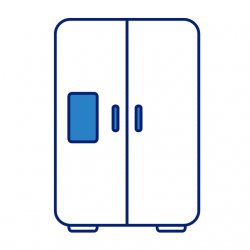Appliance Types
- Air Conditioner
- Automobile
- Chainsaw
- Circular Saw
- Dishwasher
- Drills
- Dryer
- Drywall Screw Gun
- Furnace
- Gas Fireplace
- Gas Grill
- Gas Patio Heater
- Grinder
- Heat Pump
- Impact Driver
- Impact Wrench
- Microwave
- Nailer
- Orbital Sander
- Pool Heaters
- Powerwall
- Range
- Refrigerator
- Television
- Washer
- Water Heater
Appliance Brands
- A.O. Smith
- AccuCold
- Admiral Craft
- AGA
- Airrex
- Amana
- Ambiance
- American Range
- American Standard
- American Water Heaters
- Aquacal
- Armstrong
- Asko
- Avanti
- Avenlur
- Azure
- Beko
- Bellfires
- Bertazzoni
- Blackstone
- Blaze
- Blomberg
- BlueStar
- Bosch
- Bradford White
- Bromic
- Bryant
- Cafe
- Calcana
- Capital
- Carrier
- Char-Broil
- Char-Griller
- Chrysler
- Coates
- Coleman
- Comfortmaker
- Commercial Chef
- Continental
- Cosmo
- Cove
- Crown Verity
- Dacor
- Daikin
- Danby
- Danfoss
- DaVinci
- DCS
- Deco
- DeWALT
- Ducane
- Dyna-Glo
- Dyson
- EcoSmart
- Electrolux
- Element4
- Empava
- Equator
- Eurodib
- European Home
- Everdure
- Farberware
- Fhiaba
- FibroPool
- Fire Sense
- Fisher
- FiveStar
- Flare
- Flash Furniture
- Focus
- Ford
- Forno
- Forte
- Frigidaire
- Fulgor Milano
- Gaggenau
- GE
- General Motors
- GlowBrand
- Goodman
- Grundig
- GSW
- Haier
- Hayward
- Heatstar
- Heil
- Hestan
- Hisense
- Hitachi
- Hotpoint
- iio
- Ilve
- Impecca
- Ingignia
- Insignia
- JennAir
- John Wood
- Keeprite
- Kenmore
- Kenyon
- KitchenAid
- Kucht
- La Cornue
- Lennox
- LG
- Liebherr
- Lifetime
- Lion
- Luxaire
- Lynx
- Magic Chef
- Marvel
- Maytag
- McQuay
- MicroFridge
- Midea
- Miele
- Migali
- Monogram
- Montigo
- Mr Heater
- Napoleon
- Navien
- Nexgrill
- Noritz
- Panasonic
- Patio Comforts
- Payne
- Pentair
- Perlick
- PITT
- Premier
- Raypak
- Real Fyre
- Regency
- Reliance
- Rheem
- Rinnai
- Roma
- Ruud
- Saber
- Samsung
- Schwank
- Sharp
- Smeg
- Solas
- Sony
- Spartherm
- Speed Queen
- StaRite
- State Water Heaters
- Stiebel Eltron
- SubZero
- Summerset
- Summit
- SunGlo
- SunPak
- Sunpentown
- SunStar
- Superiore
- Takagi
- TCL
- TEC
- Tempstar
- Tesla
- Thermador
- Thor Kitchen
- Toshiba
- Town and Country
- Toyota
- Traeger
- Trane
- Twin Eagles
- U-Line
- Unique
- Vaillant Group
- Valor
- Verona
- Victory
- Viessmann
- Viking
- Vizio
- Weber
- Westinghouse
- Whirlpool
- Whynter
- York
- ZLINE
Article Categories
- Air Conditioners
- Appliance Care
- Appliance News
- Dishwasher News
- Drying Machines
- Furnaces
- Gas Fireplaces
- Microwaves
- Pool Heaters
- Refrigerators
- Stoves - Ranges
- Tips and Tricks
- Washing Machines
- Water Heaters
More Articles

Refrigerator Repair
A refrigerator (colloquially fridge) consists of a thermally insulated compartment and a heat pump (mechanical, electronic or chemical) that transfers heat from the inside of the fridge to its external environment so that the inside of the fridge is cooled to a temperature below the room temperature. Refrigeration is an essential food storage technique in developed countries.
Water Leaking on the Floor
Not only is this problem dangerous to people who are walking around your kitchen, but it is also a little bit tricky to solve as it can be caused by a couple of things. Luckily, the two most common causes have a quick and easy fix that usually don’t require the help of a professional.
One cause of water leaking onto the floor is a blocked de-frost drain. The defrost drain is typically located on the back wall of the freezer, right above the slope from the floor to the back. A buildup in food particles or debris can clog the drain hose, leading to ice buildup and water leaking out of the freezer and fridge. To fix this, try draining the hole from the inside using warm water. Use a long, slender instrument such as a pipe cleaner or turkey baster to remove the clog.
If this doesn’t get the job done, you might have to manually remove the buildup that is clogging the valve at the end of the drain hose. Locate the defrost drain hose in the back of the service panel by pulling your fridge away from the wall. This hose should have a rubber valve that helps catch debris and prevent clogging. Wash the valve with hot water and soap then reinstall.
A clogged or frozen water supply can also cause water to leak on the floor and puddle under your fridge. This can also prevent the icemaker and water dispense from working properly. In order to fix this, unplug the refrigerator and locate the shut-off valve. This could be located underneath your sink, behind the fridge, or below the fridge in a basement or crawl space. Once you locate it, make sure the shut-off valve is closed and check for any problems in the plastic supply line. If it is broken or torn, you need to replace the water supply line.
If your water line is damaged, you can still use your refrigerator to keep your food cold, you just won't be able to use the ice or water dispenser.
Freezer Isn't Cold Enough
Is your perishable food spoiling quickly or are you just noticing that your freezer isn’t as frosty as it should be? This is a common problem that is usually an easy fix. If you notice this problem in your freezer unit, check if the back wall of the freezer is cold.
If it is cold, check if you can hear the evaporator fan running or if you can feel air flowing from the freezer vents. If you can’t then it is most likely a problem concerning the freezer evaporator fan. If you can feel the air flowing and hear the fan running, you should check on the refrigerator’s compressor. Clean any dust that could be preventing air from moving across the coils. These are condenser coils that release heat from inside the fridge into the room. If your condenser coils are clean, it may be time to invest in that spiffy French door refrigerator you’ve had your eye on.
Unit is Cycling Too Often
Nobody likes a noisy fridge. Not only is it inconvenient because of the constant noise, but it can also cause your energy bill to run high, taking quite the toll on your wallet. There are a few things that can cause your fridge unit to cycle too often – one being a buildup of debris or dust around the condenser coils.
To fix this, you want to begin by unplugging your fridge. The condenser coils are usually located on the very bottom of your fridge and can be accessed from the front or the back. To find the condenser coils, first locate the “grill” and remove it by popping out the snaps that hold it in place. After doing this, use a small vacuum to remove the buildup of dust or debris around the condenser coils. You may even need to use a cloth to remove any buildup in those hard-to-access places. Once all of the debris and dust is removed, put the grill back on and plug the refrigerator back in. Problem solved!
Another common cause of your refrigerator unit cycling too often is setting the temperature too low. Not only will this cause some of your food to spoil, but it also results in the refrigerator working overtime. A good rule of thumb is to set your fridge temperature at or below 40 degrees Fahrenheit. Make sure that you are checking the thermostat on your refrigerator from time to time to ensure that it is running at the correct temperature. If this doesn’t resolve the problem, it may be time to call in a repair technician as it might be the case of a defective part such as a condenser fan motor or thermostat sensor.
Fresh Food Compartment Is Warming Up
Before we can discuss the solution to this problem, it is important to understand the connection between your refrigerator and your freezer unit. Typically, the cold air generated by refrigerators comes from the freezer unit, which then flows into the fresh food section of your fridge. Therefore, if your fresh food compartment is warming up, it is most likely because you have an airflow problem.
Your freezer contains an evaporator fan that is responsible for moving the cold air from the freezer into the fresh food compartment in the fridge. This air moves through a diffuser, which is located in the back of the fresh food section of your fridge. If you can hear the evaporator fan running or can feel air blowing from the freezer vents and are still facing an issue, your diffuser duct may be clogged with ice. This is preventing air from passing through and is oftentimes caused by the door being left open for a long period of time.
However, if you can’t hear the evaporator fan running or hear an uncommon humming noise, you most likely need to invest in a new motor for your evaporator fan.
Water Dispenser Not Working
There are three possible sources that may stop your water dispenser from working.
The first, and most common reason is that your water tube in the door is frozen. To determine if this is the source of the problem, disconnect the tube at the bottom of the door and blow air through it. If the air doesn’t pass through, it is a telltale sign that your water supply tube is frozen. To fix this, simply thaw it out. To prevent this from happening again, make sure to periodically check that your freezer is set at the proper temperature. It should be set somewhere between 0 to 10 degrees Fahrenheit. If it is any lower than this, the water line could freeze.
Another possible cause for this issue is a faulty water inlet valve. This valve opens the water supply to the dispenser; therefore, if the valve is defective or if the water pressure is too low, the water valve won’t open. Before jumping to conclusions and buying a replacement part, check if the water pressure to the valve is at least 20 psi.
If your home has insufficient water pressure, it may result in your water dispenser not working. Because the water inlet valve requires a minimum of 20 psi to function properly, this may be the cause of your problem. Check the water flow from your house supply to determine if the water pressure is at least 20 psi.




